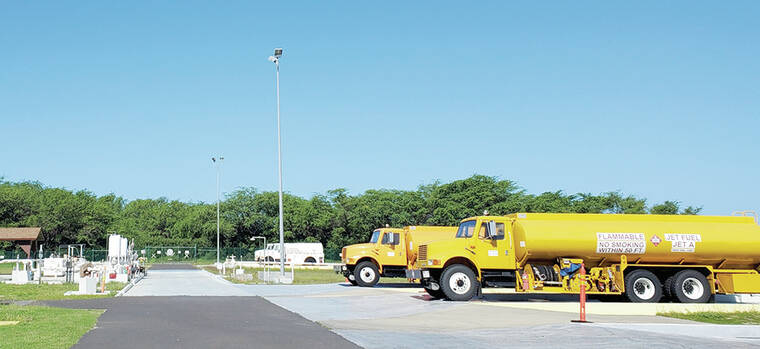BARKING SANDS — The Pacific Missle Range Facility is home to one of two field-constructed tank sites operated by the U.S. Navy in Hawai‘i.
The other is Red Hill Bulk Fuel Storage Facility on O‘ahu, where a series of leaks has prompted public outcry and a state order requiring the Navy to drain the FCTs, which was upheld by the state Department of Health last week.
Both the Red Hill and PMRF tanks were built in the early 1940s, and dispense fuel for missions. But the facilities’ similarities effectively end there, with size being the most-obvious difference between the two.
“Maximum capacity of each tank is 51,000 gallons, however, the tanks are not filled to capacity,” PMRF spokesperson Tom Clements told The Garden Island. “PMRF manages an overall total of fuel on hand, using the tanks to hold various quantities not to exceed our own established total.”
Five out of nine underground, cathodically-protected steel FCTs are in active use at Barking Sands. All hold aviation fuel.
Red Hill has 20, 12.5-million-gallon, bare-steel tanks encased in concrete, of which 18 are
operational.
Variances in proximity to drinking water and methods of fuel distribution also separate the Navy’s Kaua‘i and O‘ahu installations.
The local missile range’s tanks are not located above drinking water, while Red Hill’s were placed 100 feet above an O‘ahu aquifer.
“In addition, there are no fuel-transmission lines outside of the (PMRF) tank facility,” Clements said. “Fuel is transported to the flight line by truck.”
These trucks top-off a relatively small fleet: three turboprop planes and two helicopters belonging to PMRF, and any visiting aircraft.
In contrast, the O‘ahu FCTs dispense fuel through three underground, 2.5 mile-long pipelines that terminate at Joint Base Pearl Harbor-Hickam.
A 2016 report to the state Legislature found no current or historical fuel releases associated with the Kaua‘i FCTs.
Most recently, the Navy reported PMRF continues to pass release-detection evaluations, at the October 2021 meeting of the Hawai‘i Fuel Tank Advisory Committee.
“Monthly release-detection monitoring, as established by DOH, requires leak tests and walk-thru inspections performed at least every 31 days,” Clements said. “PMRF policy exceeds this requirement with established 14-day leak tests and 14-day walkthrough inspections.”
The inspections are performed by certified base contractor personnel, according to Clements, who said PMRF has just received funding and approval to decommission its FCTs.
All other Navy FCTs in Hawai‘i have been closed for decades, with the exception of Red Hill.
“There is no firm date yet,” Clements concluded. “But the process has begun.”
•••
Scott Yunker, reporter, can be reached at 245-0437 or syunker@thegardenisland.com.



The Homeland Defense Radar-Hawaii, proposed by the Department of Defense, likely to be sited at PMRF, would have on site storage of 150,000 gallons of diesel fuel. The complex would be built a few hundred yards from the ocean, within the tsunami zone, soon to experience the effects of rising sea level.